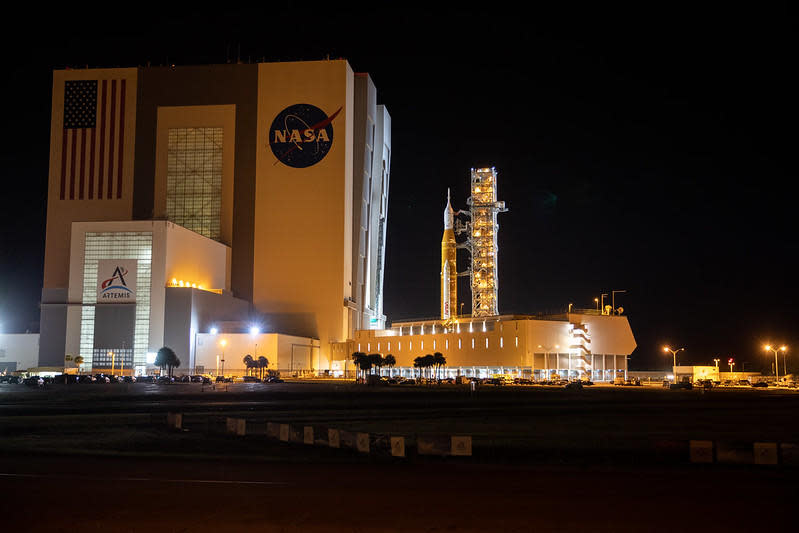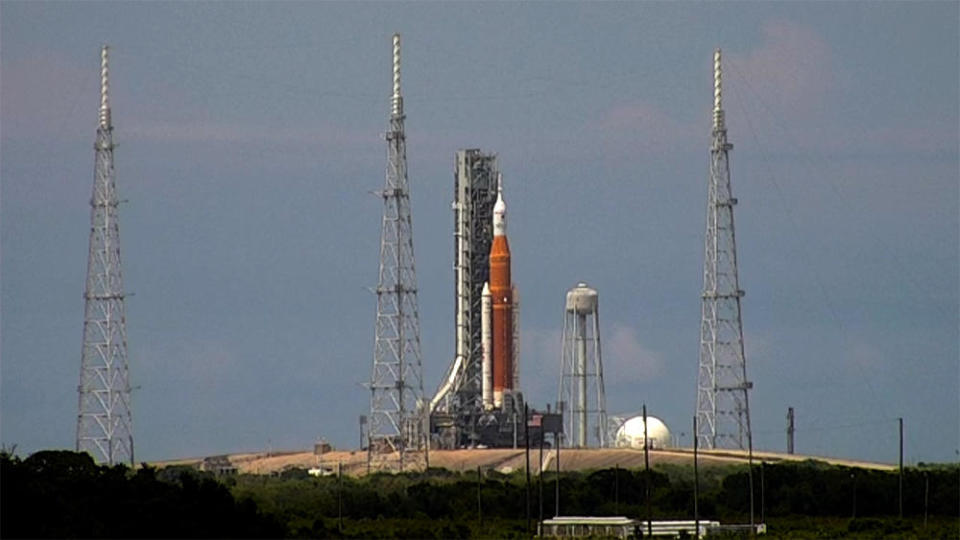NASA hauls moon rocket back to pad for key test
An upgraded Apollo-era crawler-transporter hauled NASA's oft-delayed Space Launch System moon rocket back out to its launch pad Monday for another shot at loading it with 750,000 gallons of supercold propellants in a dress-rehearsal countdown for launch late this summer.
The 4.2-mile trip from the Kennedy Space Center's iconic Vehicle Assembly Building to pad 39B began at 12:15 a.m. EDT and ended 10-and-a-half hours later when the rocket and its mobile launch gantry were "hard down" on the pad's support pedestals.

Three earlier attempts to fuel the huge rocket were derailed by a variety of problems, including a leaking hydrogen feed line fitting at the base of the core stage, a jammed helium pressurization valve and trouble getting enough gaseous nitrogen to the pad for use in fire-prevention safety systems.
The leaky fitting was the most worrying because hydrogen leaks are notoriously difficult to locate and repair at room temperature. They typically only show up when lines and tanks are exposed to cryogenic temperatures at the launch pad, but engineers are optimistic re-tightening bolts in an umbilical has solved the problem.
They'll find out one way or the other around June 19 when they plan to complete a three-day dress-rehearsal countdown by filling the rocket's first and second stages with a full load of liquid oxygen, at minus 297 degrees Fahrenheit, and hydrogen rocket fuel, at minus 423 degrees.
Assuming no leaks or other major problems show up, Launch Director Charlie Blackwell-Thompson plans to take the countdown all the way down to about the T-minus nine-second mark, the point where the main engine start sequence would normally begin. At that point, computers controlling the countdown will order a cutoff.
The Space Launch System rocket is the centerpiece of NASA's Artemis moon program, an ambitious, multi-billion-dollar effort to send astronauts back to the moon, establishing a steady cadence of flights to explore, develop in situ resources and test technologies needed for eventual Mars missions.

If the upcoming fueling test goes well, NASA managers hope to clear the rocket for launch on an unpiloted maiden flight — Artemis 1 — in the late summer timeframe, sending an unpiloted Orion crew capsule beyond the moon and back. The first test flight with astronauts aboard, Artemis 2, is planned for the 2024 timeframe with the first moon landing hoped for in 2025 or 2026.
The SLS is the most powerful rocket ever built for NASA, a two-stage booster standing 322 feet tall and weighing 5.75 million pounds when fully loaded with three quarters of a million gallons of liquid oxygen and hydrogen fuel.
Using a pair of extended shuttle-heritage solid-fuel strap-on boosters and four upgraded RS-25 shuttle main engines, the SLS will generate 8.8 million pounds of thrust at liftoff, surpassing the legendary Apollo Saturn 5 rocket.
Before committing the rocket to flight, NASA must carry out a successful test of complex countdown and fueling procedures to verify the team's ability to precisely control propellant flow rates, temperatures, pressurization and sequencing as well as procedures to safely recycle or back out of a countdown in case of trouble.
NASA initially hauled the Artemis 1 SLS out to pad 39B on March 18 for a tanking test on April 3, but a series of unrelated technical glitches blocked three attempts to complete the exercise, stopping the countdown before it ever reached the terminal phase.
On April 15, the rocket was hauled back to the Vehicle Assembly Building for inspections, tests and repairs of the first stage hydrogen fitting, the upper stage helium valve and a handful of other items.
At the same time, Air Liquide, the off-site vendor that delivers nitrogen to the space center via pipeline, carried out upgrades to ensure adequate supplies.
While NASA managers hope to carry out the dress rehearsal around June 19, extra time has been built into the schedule in case bad weather or other issues force another delay.
Georgia secretary of state testifies in Trump election probe

